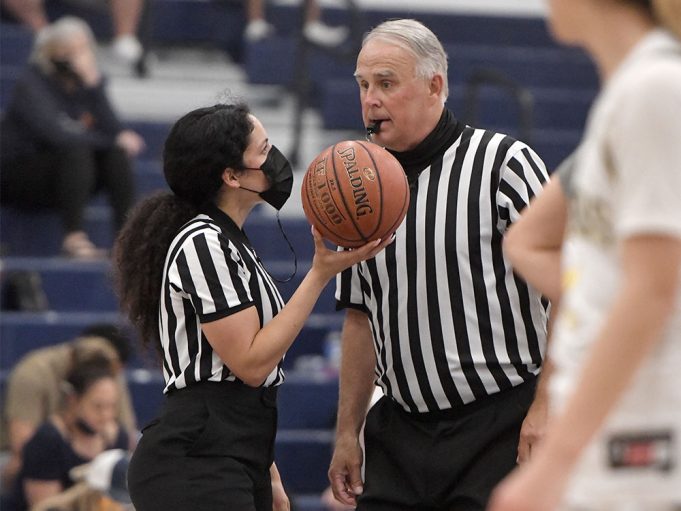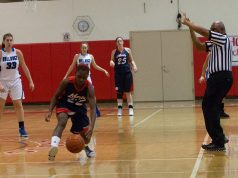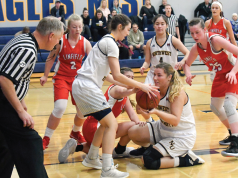Arequirement on the list of items that should be discussed during a crew’s pregame meeting is how everyone will handle information related to a loose ball going out of bounds.
These plays can happen in a flash, with the added complication that many times the ball is traveling from outside the ruling official’s primary coverage area, creating a situation where there may be no definite knowledge by that official about who actually last touched the ball before it became dead.
The ruling official, whether responsible for the endline or a sideline, will have one of three possible trains of thought as the ball touches someone or something out of bounds:
- I have definite knowledge about which team last touched the ball and which team should now be awarded a throw-in.
- I am reasonably confident about which team last touched the ball and which team should now be awarded a throw-in.
- I don’t have the faintest idea about which team last touched the ball and which team should now be awarded a throw-in.
The first option is of course the least problematic. The official makes a ruling, everyone in the gym, including Grandma in the top row, agrees and play resumes. No muss, no fuss.
The third option, believe it or not, is also typically an easy one to resolve, so long as it has been addressed in the pregame. In this situation, as soon as the ruling official realizes he or she does not have the necessary information to make an informed ruling, the official should ask for help from the partner best equipped to offer it. The mechanic is simple — blow your whistle, make eye contact with said partner and ask loudly enough to be heard, “Help?” When asked, the partner should make a decision and sell it both verbally and physically by blowing the whistle and loudly proclaiming who should have possession — “Blue!” with an emphatic signal in the direction of the blue team basket.
The verbiage used in the pregame regarding these plays will often go something like this: “If I ask for help, it means I have no idea. Make the call and own it, and as a crew we will accept it, no questions asked.”
It’s the second option of the three listed above that can pose a real-time problem for crews that neglect this particular play during their pregame. Because the last thing you want is an argument between two stubborn crewmates about what they saw and no clean way to resolve it.
Let’s use the following example as a jumping-off point for discussion: A1, standing outside the three-point line near the trail official, zips a pass toward A2 on the low block on the weak side of the floor. The ball is not caught and hits the wall behind the endline. The lead official blows the ball dead and signals a throw-in for team B. However, there is a question about whether B3, standing in the middle of the free-throw lane, actually tipped the ball while it was being passed between teammates.
The pregame discussion by the officiating crew for any play similar to this should operate as follows:
- The ruling official needs to make a preliminary judgment on any out-of-bounds play, unless immediately seeking help and abdicating that choice to a partner, as described earlier in this article.
- Once the ruling official makes a decision, if another official on the floor “thinks” that ruling may be incorrect, it stands as called and there is no need for any type of crew discussion.
- Once the ruling official makes a decision, if another official on the floor “knows” that ruling is incorrect, those two officials should get together, with the ruling official using the new information to correct the ruling.
The key difference is what a crew “thinks” and what a crew “knows.” If an official “thinks” he or she has information that might alter a ruling, that’s not a good enough standard. That information is best left in the official’s mind and has no place coming out of the official’s mouth, where it will only complicate matters, creating a situation where there are now two officials playing the guessing game.
If an official “knows” he or she has information that will create a correct ruling, not only should it be shared, but the ruling official on the play should be willing to accept it and use it to overturn his or her original decision.
The pregame discussion goes like this: “If I think an out-of-bounds ruling is incorrect, I am not saying anything. If I know the ruling is incorrect, I am coming to you with that information and I expect you to use it. Conversely, if you come to me and tell me that you have information that my original ruling is incorrect, I am 100 percent changing my ruling without further discussion.”
If everyone on the crew agrees to these standards before stepping on the court, it eliminates the possibility that two officials will become embroiled in disagreement in real time should one of these plays come to fruition. It puts the entire crew on confident footing, knowing a partner is only going to step into the situation when there is definite knowledge available that will result in a new ruling.
Lead official: “White!”
Center official: Tweet. Tweet. Tweet. “Partner, I’ve got 100 percent knowledge the ball was last touched by white. It should be red ball.”
Lead official: “Red!”
No need for any additional communication on the floor. You and your partners have already done so in the locker room, secure in the knowledge that you are all on the same page.
What's Your Call? Leave a Comment:
Note: This article is archival in nature. Rules, interpretations, mechanics, philosophies and other information may or may not be correct for the current year.
This article is the copyright of ©Referee Enterprises, Inc., and may not be republished in whole or in part online, in print or in any capacity without expressed written permission from Referee. The article is made available for educational use by individuals.


















